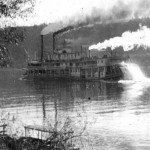In early 2006, Colgate-Palmolive announced that its toothpaste plant in Clarksville, Indiana would relocate to Morristown, Tennessee by 2008. Another indication of Indiana’s shift from a manufacturing-based economy, the news came as a blow to the plant’s 500 employees, along with economic forecasters in Southern Indiana. But exponents of historic preservation were also distressed by the announcement.
Clarksville’s Colgate-Palmolive plant occupies a 942,000-square foot Romanesque Revival structure that originally served as the Indiana Reformatory South. Originally erected in 1847, the main prison complex dates to 1890, at which time it was known for its furniture manufacturing facilities, fueled by prison labor. The building sustained a massive fire in 1918, and was sold to Colgate in 1921, which retooled the plant for soap production with the assistance of the remaining prisoners.
The enormous clock that graces the roof of the Colgate building has made it an Ohio River landmark area since the 1920s. Illuminated by red bulbs at night, its octagonal dial measures more than 40 feet across, making it the world’s second-largest clock. Larger even than Big Ben, the clock was crafted by the Seth Thomas Company in 1906 to commemorate Colgate’s centennial. The clock cast its glow on the Hudson River from its perch atop the firm’s flagship plant in Jersey City, New Jersey until 1924, when it was moved to its present location.
Although the Colgate-Palmolive Plant and Clock is not on the National Register of Historic Places, it has been named one of the Ten Most Endangered sites by Historic Landmarks Foundation of Indiana. The site does not appear to require environmental remediation, but its preservation challenges are admittedly formidable. Regardless of the building’s outcome, Colgate plans to leave the landmark timepiece on the banks of the Ohio.
Sources for this program include:






















